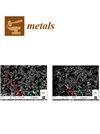Research on Discrete Clamp Motion Path Control-Based Stretch-Forming Method for Large Surfaces
IF 2.5
3区 材料科学
Q3 MATERIALS SCIENCE, MULTIDISCIPLINARY
引用次数: 0
Abstract
In this paper, a near-net discrete clamp motion path control (SF-CMPC)-based stretch-forming method is proposed as a solution for the low-cost high-quality machining of highly curved surfaces. In this approach, the clamps are discretized, the motion paths are designed to control deformation distribution and avoid forming defects, the stretch-forming transition zone can be effectively reduced, the material utilization rate can be increased, and the near-net formation of large surfaces can be achieved. To investigate this method’s feasibility, the conventional stretch-forming (SF-C) and SF-CMPC processes are numerically analyzed. The results indicate that, upon increasing the transition zone length via SF-CMPC, the maximum thickness reduction and strain value are reduced by 0.010 mm and 0.0249, respectively, with the dependence of the forming quality on the transition zone length being significantly reduced compared to SF-C. In the formation of surfaces with large curvatures, SF-CMPC’s crack risk is lower than SF-C’s crack risk, with better adaptability. Through controlling the contact process with a die, the sheet metals’ constraint state is improved, the transverse compressive strain can be effectively reduced via friction, and the wrinkling defects can be suppressed. A stretch-forming experiment was carried out on a spherical surface, using self-developed equipment. The feasibility of achieving surfaces’ near-net stretch forming by controlling the clamps’ motion paths was hereby proven.基于离散夹具运动路径控制的大表面拉伸成形方法研究
本文提出了一种基于近净离散夹具运动路径控制(SF-CMPC)的拉伸成形方法,作为低成本高质量加工高曲面的解决方案。该方法将夹具离散化,设计运动路径以控制变形分布和避免成形缺陷,可有效减少拉伸成形过渡区,提高材料利用率,实现大曲面的近净成形。为了研究这种方法的可行性,我们对传统的拉伸成形(SF-C)和 SF-CMPC 工艺进行了数值分析。结果表明,通过 SF-CMPC 增加过渡区长度后,最大厚度减少量和应变值分别减少了 0.010 毫米和 0.0249,与 SF-C 相比,成形质量对过渡区长度的依赖性明显降低。在形成大曲率表面时,SF-CMPC 的裂纹风险低于 SF-C,具有更好的适应性。通过控制与模具的接触过程,改善了金属板的约束状态,通过摩擦有效降低了横向压缩应变,抑制了起皱缺陷。利用自主研发的设备对球形表面进行了拉伸成形实验。证明了通过控制夹具运动轨迹实现表面近净拉伸成形的可行性。
本文章由计算机程序翻译,如有差异,请以英文原文为准。
求助全文
约1分钟内获得全文
求助全文
来源期刊

Metals
MATERIALS SCIENCE, MULTIDISCIPLINARY-METALLURGY & METALLURGICAL ENGINEERING
CiteScore
4.90
自引率
13.80%
发文量
1832
审稿时长
1.5 months
期刊介绍:
Metals (ISSN 2075-4701) is an open access journal of related scientific research and technology development. It publishes reviews, regular research papers (articles) and short communications. Our aim is to encourage scientists to publish their experimental and theoretical results in as much detail as possible. Therefore, there is no restriction on the length of the papers. The full experimental details must be provided so that the results can be reproduced. Metals provides a forum for publishing papers which advance the in-depth understanding of the relationship between the structure, the properties or the functions of all kinds of metals.
 求助内容:
求助内容: 应助结果提醒方式:
应助结果提醒方式:


